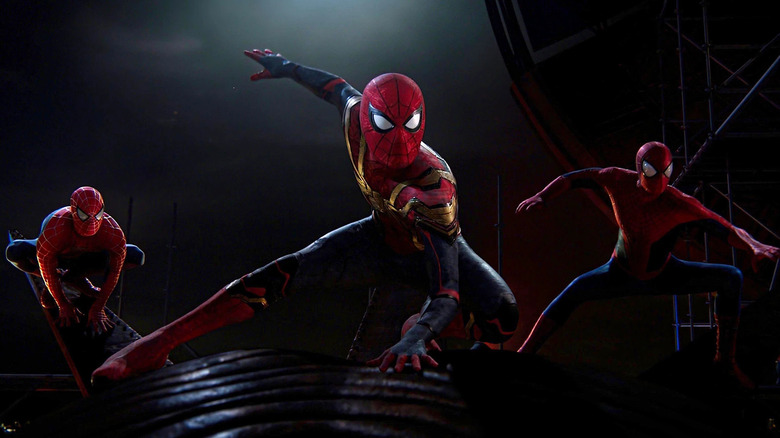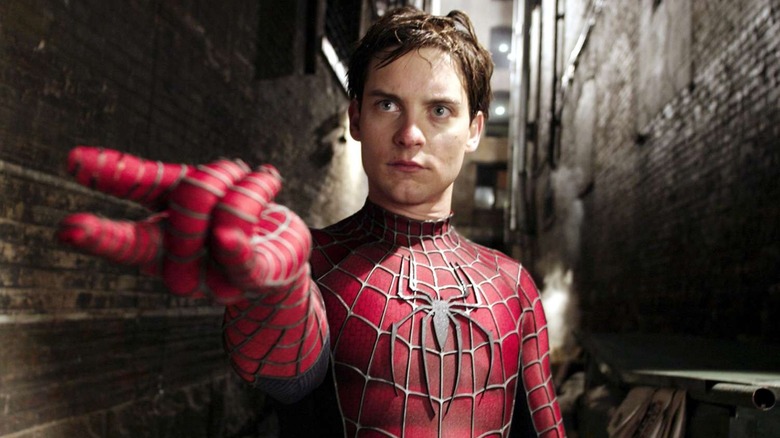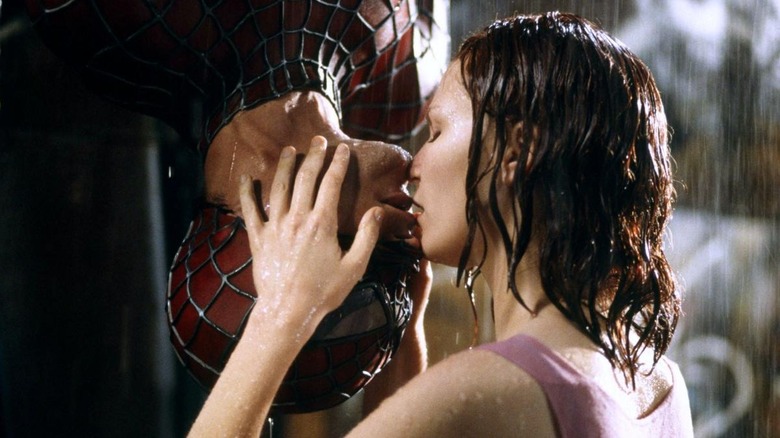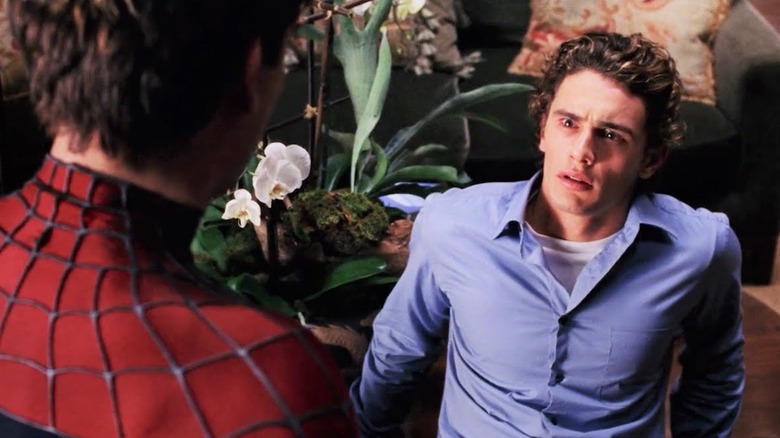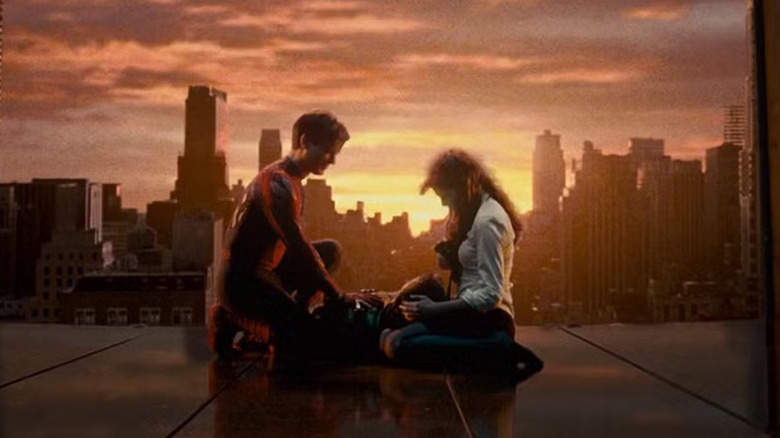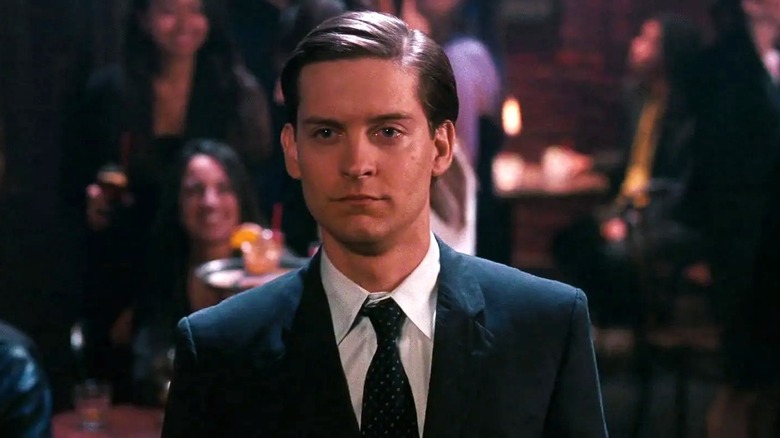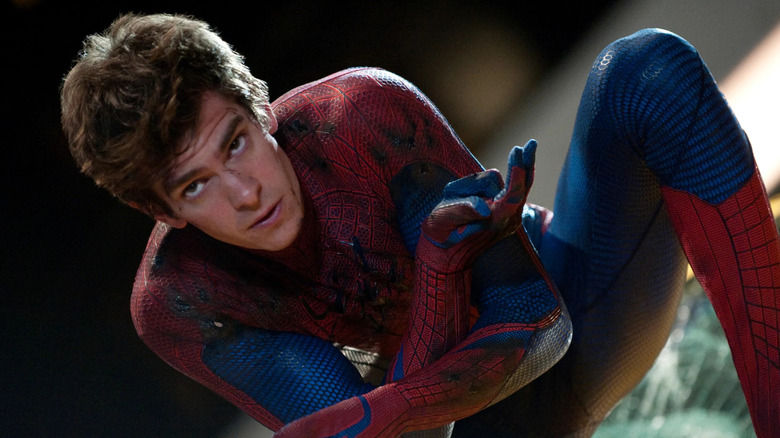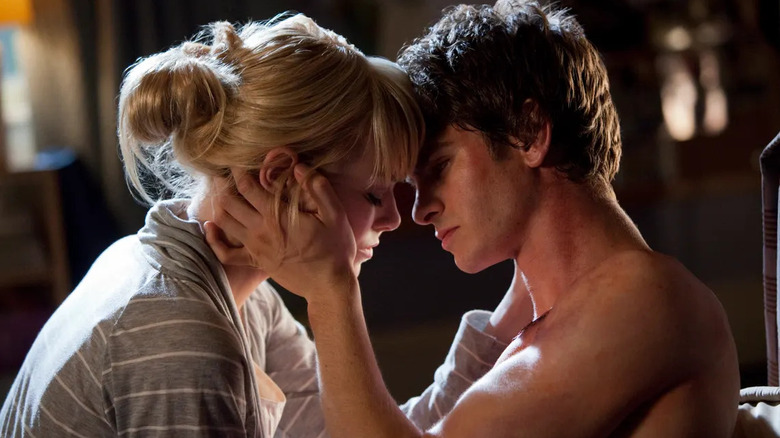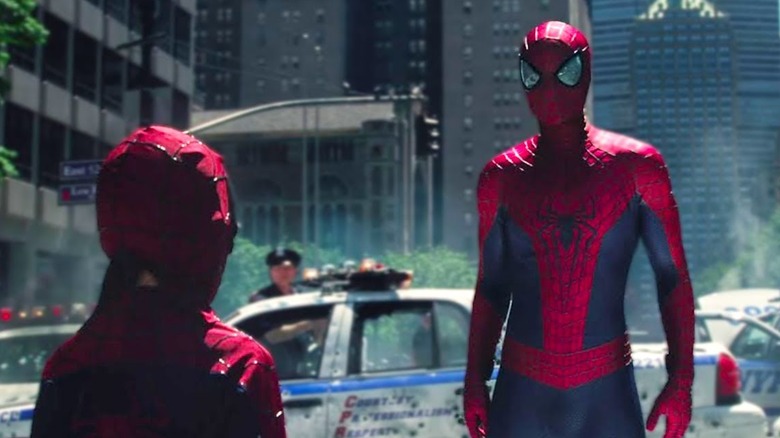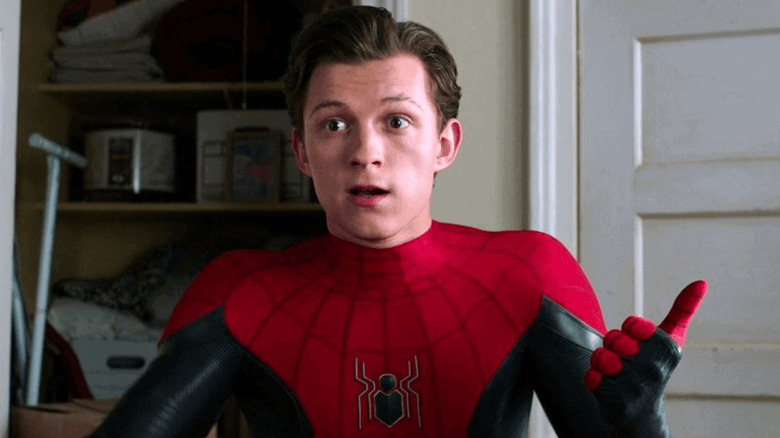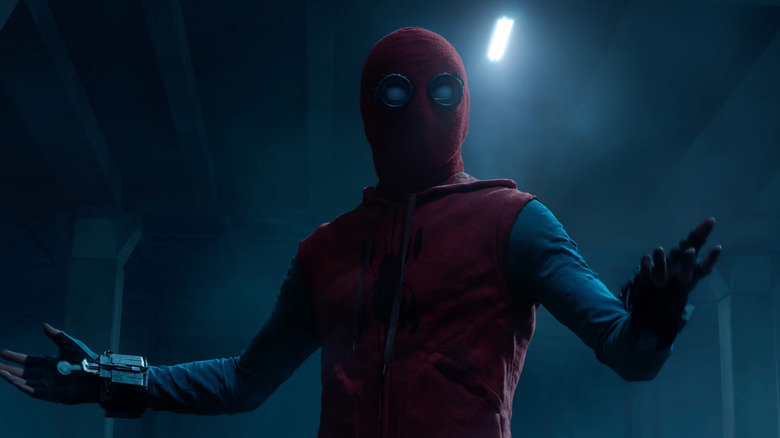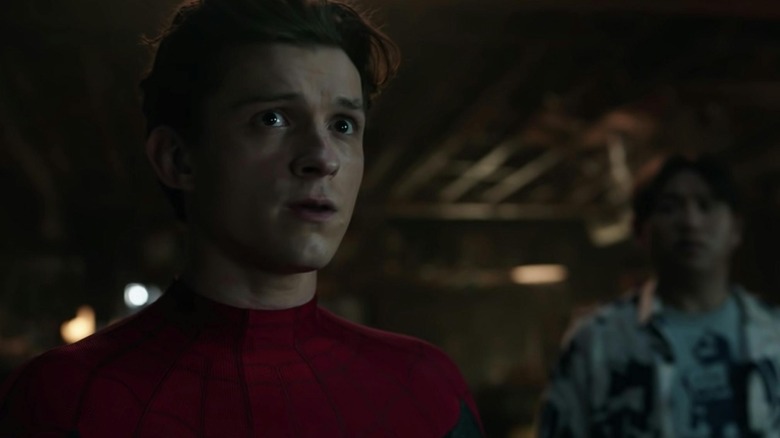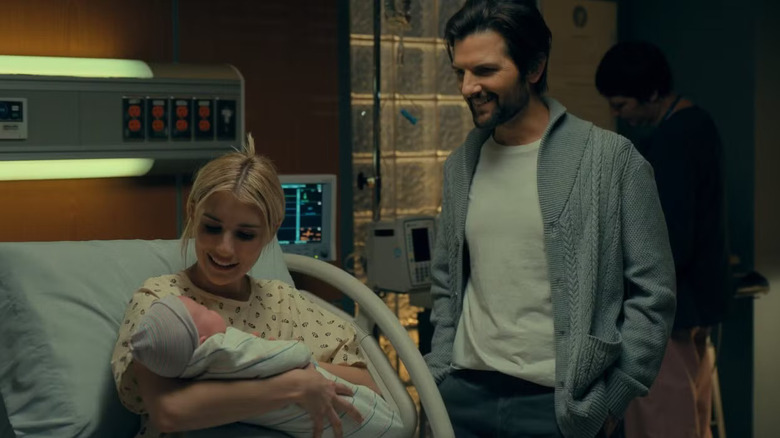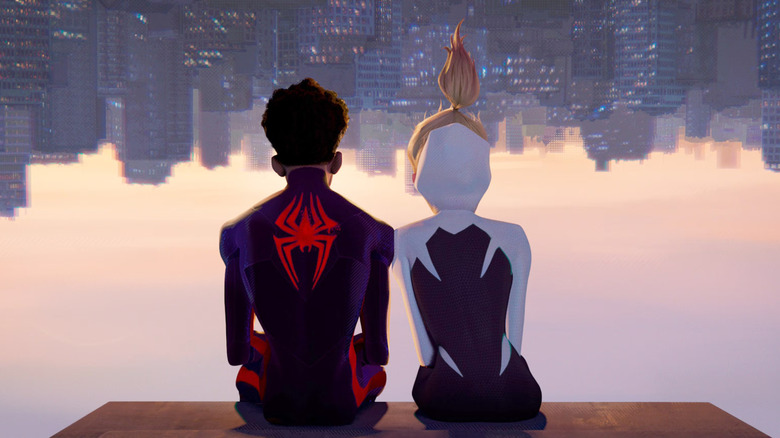The Complete Spider-Man Movie Timeline (So Far) Explained
The Spider-Man film franchise is often credited with revitalizing the superhero film for the modern era, thanks to Sam Raimi's trilogy beginning in 2002. Since then, the webhead has become one of the highest-grossing film characters of all time, making appearances in blockbusters like "Spider-Man: No Way Home" and "Avengers: Infinity War."
Because the rights to the Spider-Man film franchise and related characters are owned by Sony Pictures, the character's on-screen presence was initially separate from the events of the Marvel Cinematic Universe. In 2015, Sony and Marvel Studios reached an agreement to collaborate on bringing the character to the MCU in "Captain America: Civil War," leading to Tom Holland's portrayal, which was even praised by Stan Lee himself.
The Spider-Man film universe timeline is, like the comic books, a little convoluted. Fans have been trying to wrap their heads around the timeline of these movies. Here is everything you need to know about the timelines of each Spider-Man franchise.
Tobey Maguire's Spider-Man timeline, explained
A live-action Spider-Man movie had been in the works for more than 15 years before Sam Raimi came on board to direct. Tobey Maguire was cast as Peter Parker, a high schooler who, after being bitten by a radioactive spider while on a field trip, discovers that he now possesses the insect's abilities, including climbing walls, shooting webs, and incredible strength proportionate to his body.
While the first film, released in 2002, feels like a classic high school coming-of-age story, subsequent installments explore Peter struggling through early adulthood while also anonymously saving New York City as Spider-Man. Meanwhile, he also attempts to figure out his personal relationships, from the contentious brotherly love with Harry Osborn (James Franco) — that turns into a bitter rivalry — to his complicated, messy romance with Mary Jane Watson (Kirsten Dunst).
"Spider-Man 2" came out in 2004, quickly following up the first film's critical and commercial success. "Spider-Man 3" suffered from studio interference throughout development, resulting in a film that divided fans and critics upon release, remaining a contentious topic of debate among online circles.
Spider-Man (2002)
Despite being released in spring 2002, many fans accept that, according to canon, Sam Raimi's first Spider-Man movie takes place in 2001. One of the film's web-slinging montages features an identifiable shot of the Twin Towers in the background, indicating that its events precede the September 11 terrorist attacks. An early teaser trailer featured a scene in which a helicopter is ensnared in a web between the towers, but this was changed prior to the film's release.
The film documents the origins of Tobey Maguire's Peter Parker, who quickly adopts the Spider-Man moniker as a wrestling persona after discovering his newfound powers. However, after failing to save his Uncle Ben (Cliff Robertson) from a robber, Peter takes up vigilantism, using photographs taken by himself to sell to hot-headed Daily Bugle editor J. Jonah Jameson (J.K. Simmons) and support his widowed Aunt May (Rosemary Harris).
Things come to a head for Peter when Norman Osborn's (Willem Dafoe) performance-enhancing experiments drive him mad, resulting in the Oscorp CEO donning a green suit of armor and terrorizing New York as the Green Goblin. In Peter's climactic battle against Osborn, Osborn is accidentally killed by his own glider. Harry vows revenge on Spider-Man, unaware of his true identity, while Peter eschews his feelings for Mary Jane to protect her from further danger.
Spider-Man 2 (2004)
"Spider-Man 2," arguably the best of Sam Raimi's trilogy, picks up in 2003, two years after the events of its predecessor; Aunt May tells Peter during the film it's been that long since Uncle Ben's murder. In that time, Peter has become distant from Harry and M.J., but finds an unlikely mentor in Otto Octavius (Alfred Molina), a scientist working on a fusion power machine for Oscorp, only to become corrupted by A.I. tentacles that wreak havoc.
Donning the moniker Doctor Octopus, Octavius toils on rebuilding his machine with Harry's help, while a powerless Peter gives up saving lives as Spider-Man in pursuit of a normal life. It's not long before Peter realizes the cost of taking off the mask, because as Uncle Ben told him, with great power comes great responsibility. After Octavius kidnaps M.J. to taunt Peter, Spider-Man is captured and brought to Harry as part of the villains' agreement, only for Harry to find out that his father's killer is actually his former best friend.
Despite their differences, Peter convinces Harry to help save M.J. from Octavius, whose fusion power machine nearly destroys New York City before Otto sacrifices himself to destroy it. Mary Jane and Peter finally admit their feelings for each other, even though she knows his secret identity too.
Spider-Man 3 (2007)
Despite coming out in 2007, three years after "Spider-Man 2," "Spider-Man 3" takes place in 2005, as indicated by a sign advertising the Tony Awards, which took place in June of that year. It's only been a year since the end of the previous film, giving Harry enough time to plot his revenge against Peter. En route to propose to M.J., Peter is ambushed by Harry, who is utilizing his father's Green Goblin tech. This results in a fight where Harry is knocked out and develops amnesia, forgetting Spider-Man's true identity.
Things get more complicated from there. Peter's suit is corrupted by an extra-terrestrial symbiote, and he encounters Uncle Ben's killer: Flint Marko (Thomas Haden Church), a recently-escaped convict who has become fused with sand particles after falling in a particle accelerator. In his "Emo Peter" phase, corrupted by the symbiote, Peter alienates M.J. and gets fellow Daily Bugle photographer Eddie Brock (Topher Grace) fired.
The film's final act sees Peter reject the symbiote, tearing it off and leaving it to corrupt Brock, who transforms into the supervillain Venom and teams up with Marko to defeat Spider-Man. After Harry realizes Peter's innocence in his father's death, he comes to aid Peter in the fight against the two villains, only for Venom to kill Harry before being caught in an explosion from one of Norman's pumpkin bombs. In the final scene, Peter and M.J. share an embrace as they look to reconcile their relationship.
What comes next for Tobey Maguire's Spider-Man?
We'll never know if a proper "Spider-Man 4" starring Tobey Maguire will happen, despite Sam Raimi confirming in 2022 that he'd be open to directing it if offered. We do have some details about what Raimi's film was supposed to look like, as development proceeded for years after the release of "Spider-Man 3." The earliest discussions involved Dylan Baker's Dr. Curt Connors becoming the Lizard, as well as Bruce Campbell (who cameoed in all three films) appearing as Mysterio.
The only movement on the film was in 2009, when it was reported that John Malkovich was in talks to play the Vulture and Anne Hathaway would play Felicia Hardy, aka the Black Cat. Sadly, after several failed drafts, Raimi decided to walk away from "Spider-Man 4" and allow Sony the opportunity to reboot the franchise.
However, due to Tobey Maguire's appearance in "Spider-Man: No Way Home," fans have an idea how Peter Parker's life turned out in the years after "Spider-Man 3." He confirms in the film to Andrew Garfield's Peter that, despite their ups and downs, his relationship with M.J. is still going strong. What's most revealing is Peter admitting he's spent years thinking of an anti-Goblin serum, perhaps wondering about what he could have done differently in the past.
Andrew Garfield's Spider-Man timeline, explained
Following Sam Raimi's scrapped "Spider-Man 4," Sony Pictures gave the franchise reins to director Marc Webb, casting Andrew Garfield to play a new interpretation of Peter Parker in "The Amazing Spider-Man." Tonally, this series is much more reminiscent of the Marvel Cinematic Universe, compared to the campiness of Raimi's films. As Webb told The Los Angeles Times of his approach, "I wanted it to be more grounded and more realistic," calling it "less based in Steve [Ditko's] world and probably closer visually and more influenced by 'Ultimate Spider-Man.'"
While many fans felt "The Amazing Spider-Man" and its sequel, "The Amazing Spider-Man 2," didn't live up to the action and visual style of Raimi's films, they did boast one incredible feature: the romance. Andrew Garfield's scene partner in both films was Emma Stone as Gwen Stacy, with their romantic tension showing on-camera and leading to a real-life relationship between the co-stars.
Although "The Amazing Spider-Man" retreads many early plot points of the 2002 "Spider-Man" film, the inclusion of Gwen Stacy over Mary Jane Watson opened up a lot of new avenues for the film franchise to explore from the comics. Unfortunately, some of those avenues led to a tragic turn of events.
The Amazing Spider-Man (2012) and The Amazing Spider-Man 2 (2014)
"The Amazing Spider-Man" starts years before Peter Parker ever gets near a radioactive spider. In 2001, a six-year-old Peter is left with Aunt May and Uncle Ben shortly before his father's death. Eleven years later, teenage Peter Parker's late-night visit to Oscorp sees him get bitten by a radioactive spider, and after a familiar sequence of events, he becomes the web-slinging, crime-fighting Spider-Man.
As Peter's romance with classmate Gwen Stacy blossoms, he reveals his identity to her. Peter teams up with Gwen's father, NYPD Captain George Stacy (Denis Leary), to fight Dr. Curt Connors (Rhys Ifans), an Oscorp employee whose experiments have transformed him into the Lizard. When Captain Stacy is killed, he makes Peter promise to stay away from Gwen, but in "The Amazing Spider-Man 2," which takes place two years later in 2014, Peter has trouble keeping his word.
Peter's double life as Spider-Man puts Gwen in jeopardy, as he's targeted by superfan-turned-menace Max Dillon, aka Electro (Jamie Foxx), as well as former childhood friend Harry Osborn (Dane DeHaan), who becomes the Green Goblin in search of a cure for his father. During the fight with Osborn, Peter tragically fails to save Gwen from a fatal fall. After a brief hiatus from crime-fighting out of guilt, Peter decides to don the suit again and fight the Rhino (Paul Giamatti).
What comes next for Andrew Garfield's Spider-Man?
It's obvious from the ending of "The Amazing Spider-Man 2" that Sony had plans to continue the franchise, with hints about introducing the Sinister Six as well as exploring Norman Osborn's story. But what really happened with "The Amazing Spider-Man 3" was that Sony was disappointed with the previous film's box office take and critical response, eventually resulting in Sony agreeing to let Marvel Studios reboot the character and introduce him into the MCU.
Unfortunately, this meant leaving behind Andrew Garfield, who told Variety, "I signed up to serve the story, and to serve this incredible character that I've been dressing as since I was three, and then it gets compromised and it breaks your heart." Thankfully, due to Garfield's reprisal of the role in "Spider-Man: No Way Home," the door seems open for his future as Peter Parker. Garfield's Peter revealed in "No Way Home" that in the years since Gwen Stacy's death, he defeated the Rhino, but described his vigilantism as becoming more "rageful" and "bitter" as time passed.
Tom Holland's Spider-Man timeline, explained
Tom Holland made his debut as Peter Parker in 2016's "Captain America: Civil War," joining the already-existing timeline of the Marvel Cinematic Universe. In "Civil War," which takes place in 2016 (according to newspapers shown early in the film), Parker is recruited by Tony Stark (Robert Downey Jr.) to aid in a skirmish between the Avengers regarding the Sokovia Accords, which seeks to restrict the operations of masked vigilantes by putting them under the government's watchful eye — something Stark and Steve Rogers (Chris Evans) vehemently disagree on.
In previous MCU films, the Avengers are responsible for some severe devastation. In 2012, the team's first assembly leads to the Battle of New York (in "The Avengers," also released in 2012), which sees unprecedented levels of infrastructure destroyed. Roughly a year before the events of "Captain America: Civil War," the Avengers defeat Ultron and, in the process, decimate the country of Sokovia. That incites the ire of terrorist Helmut Zemo (Daniel Bruhl), who instigates the Avengers' internal conflict by staging a U.N. attack and pinning it on a fugitive Bucky Barnes (Sebastian Stan).
Although Peter Parker's role in the film is notably small, this is where he's given his first proper Spider-Man suit by Stark. In a post-credits scene, Peter is also gifted a pair of high-tech web shooters from Stark, setting the character up for his adventures in 2017's "Spider-Man: Homecoming."
Spider-Man: Homecoming (2017)
"Spider-Man: Homecoming" opens in 2012, in the aftermath of the Battle of New York. Adrian Toomes (Michael Keaton), a contractor cleaning up the city, is sidelined by government operatives under Tony Stark's supervision. Bitter towards Iron Man for screwing over the little guy, Toomes sells the Chitauri tech he's scavenged on the black market, and begins stealing more in a high-tech winged suit.
A minor continuity error happens when the screen flashes "eight years later" after the opening. According to the official MCU timeline, "Spider-Man: Homecoming" takes place in 2016, which is actually just four years after the events of "The Avengers." Hot off the events of "Civil War," Peter Parker resumes his normal life while maintaining his secret identity as Spider-Man, though it's not long before Aunt May (Marisa Tomei) and his best friend Ned (Jacob Batalon) find out.
The film follows Peter's struggle of learning to be responsible as Spider-Man, going against Stark's orders to ignore the business dealings of the Vulture. Even after having his suit taken away, Peter successfully hands Toomes over the police, and as a reward for his impressive feat, Stark offers him a place on the Avengers with an upgraded Iron Spider suit, but Peter turns it down ... for now.
Spider-Man: Far From Home (2019) and Spider-Man: No Way Home (2021)
There's a lot to catch up on between "Spider-Man: Homecoming," released in 2017, and "Spider-Man: Far From Home," which came out only two years later in 2019. What's important to know is that in "Avengers: Infinity War," Peter Parker is blipped out of existence by Thanos in the year 2018, only to be returned five years later in 2023. "Far From Home" picks up a year later in 2024, as Peter and his friends finish their restarted school year.
While on a class trip in Europe, Peter's possession of the E.D.I.T.H. A.I. attracts the attention of former Stark employee Quentin Beck (Jake Gyllenhaal), who masquerades as a superhero named Mysterio in order to gain Peter's trust and steal it. Although Peter defeats Mysterio (and admits his feelings for M.J.) upon returning to New York, his identity as Spider-Man is leaked to J. Jonah Jameson, leading directly into the events of 2021's "Spider-Man: No Way Home."
Desperate to escape the difficulties of his identity being revealed, Peter seeks the help of Doctor Strange (Benedict Cumberbatch), his "Infinity War" comrade, to cast a memory spell on the entire world. Unfortunately, this causes a rift in space-time, making Peter the target of villains from the Tobey Maguire and Andrew Garfield timelines. After teaming up with his older selves, the three Peters defeat the "Sinister Five," and Peter pays the price for his mistakes by losing Aunt May and convincing Strange to make everyone, including Ned and M.J., forget he ever existed. In the film's final moments, Peter dons a new, custom-made Spider-Suit as he swings anonymously through a wintry New York City.
The Sony-Verse timeline, explained
In the live-action Sony Spider-Man Universe (which doesn't actually feature Spider-Man), timelines get even more messy. 2024's "Madame Web" has plenty of dumb things everyone ignores, including the reveal of an indigenous tribe of Peruvian Spider-People. The film takes place in 2003, centering on Cassandra Webb (Dakota Johnson), an EMT who works alongside a young Uncle Ben Parker (Adam Scott) and who discovers her powers of precognition. Cassie helps save several future Spider-Women, as well as Mary Parker (Emma Roberts), who gives birth to Peter — although we're not sure which version of Peter it is.
The "Venom" movies exist in a different timeline than the MCU, though there's been crossover. The first "Venom" takes place in 2018, and its sequel, "Venom: Let There Be Carnage," a year later in 2019. However, the post-credits scene of "Let There Be Carnage" sees Eddie Brock transported to the MCU universe of 2024 (the "Venom" timeline never experienced the Blip), before being sent home during another post-credits scene in "Spider-Man: No Way Home."
More unexplainable timeline jumbling happens in "Morbius," when the MCU's Adrian Toomes is transported to Michael Morbius' (Jared Leto) timeline. After escaping from prison and donning his Vulture suit, Toomes encourages Morbius to team up against Spider-Man for some unknown reason, which will likely never be explored on-screen thanks to Morbius (and "Kraven the Hunter") bombing at the box office.
The Spider-Verse timeline, explained
The "Spider-Verse" film series is much more straightforward, timeline wise. "Spider-Man: Into the Spider-Verse," which came out in winter of 2018, happens to also take place in the winter of 2018, as evidenced by Peter Parker's gravestone shown early in the film. "Into the Spider-Verse" mainly follows the origin story of Miles Morales (Shameik Moore) on Earth-1610, who teams up with other versions of Spider-Man from other dimensions, including Peter B. Parker (Jake Johnson) and Gwen Stacy (Hailee Steinfeld), to stop Kingpin (Liev Schreiber) from activating a dangerous collider funded by the tech company Alchemax.
"Spider-Man: Across the Spider-Verse," released in 2023, takes place 16 months after the events of "Into the Spider-Verse," placing it in early 2020. Miles has made an enemy out of The Spot (Jason Schwartzman), a former scientist who briefly appears in "Into the Spider-Verse" before being caught in Kingpin's collider. The sequel sees Gwen taking Miles to join the Spider-Society, an organization of every Spider-Man variant, until he's targeted by Miguel O'Hara (Oscar Isaac), a time-traveler from the year 2099, as an anomaly. "Across the Spider-Verse" ends on a cliffhanger as Miles is captured by a variant of himself from Earth-42, setting up the trilogy to end with the upcoming "Spider-Man: Beyond the Spider-Verse."
